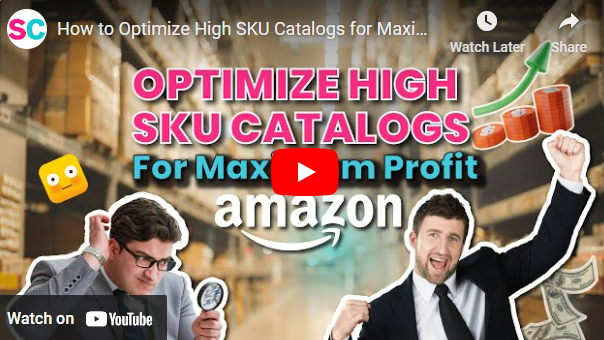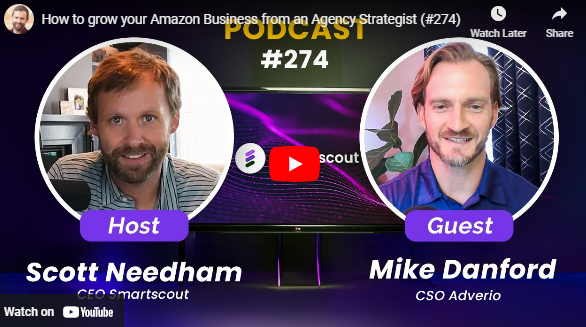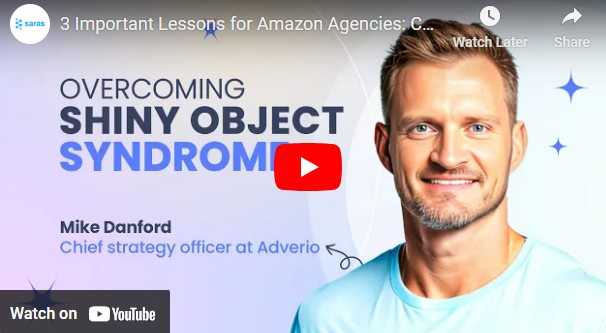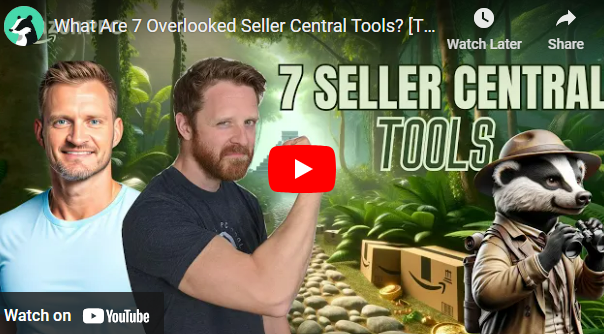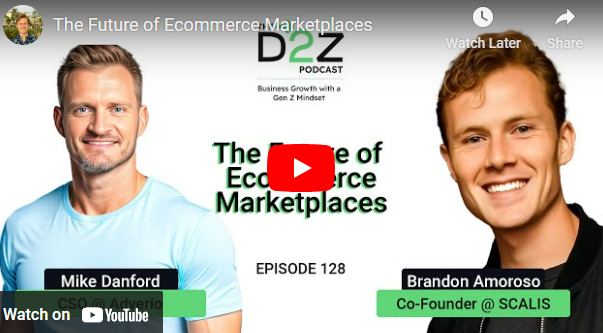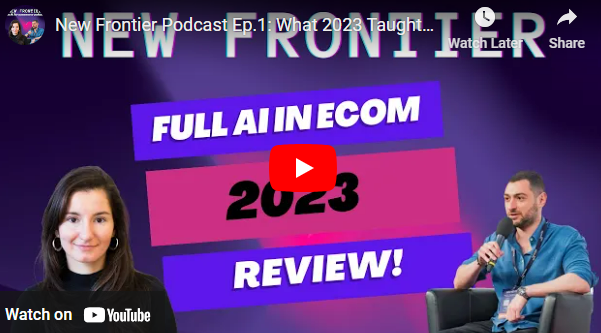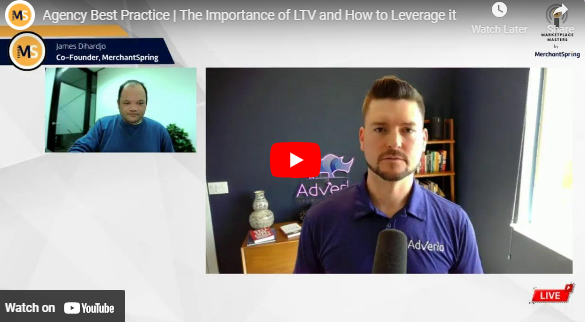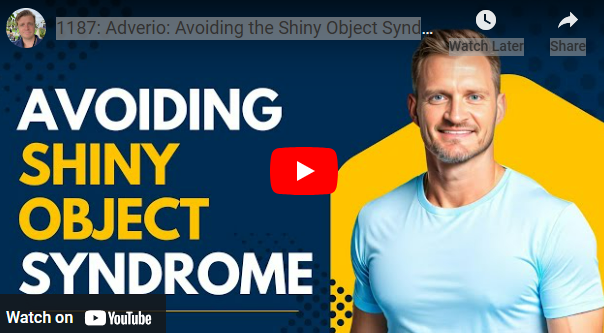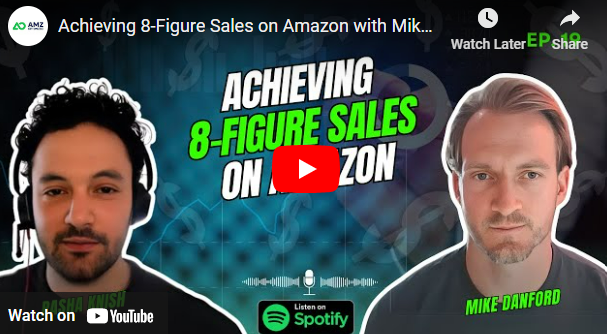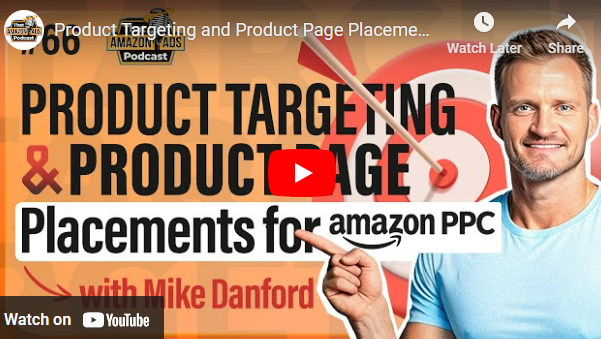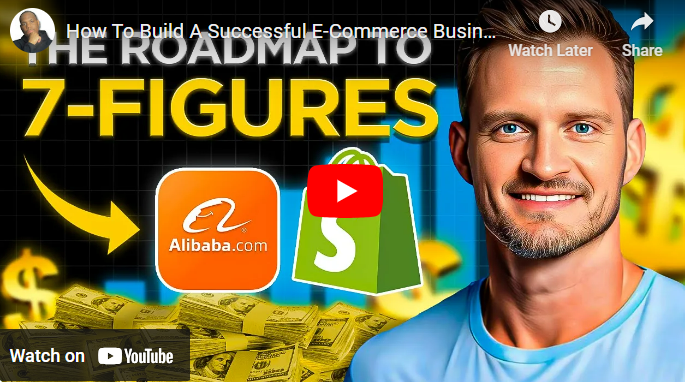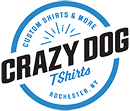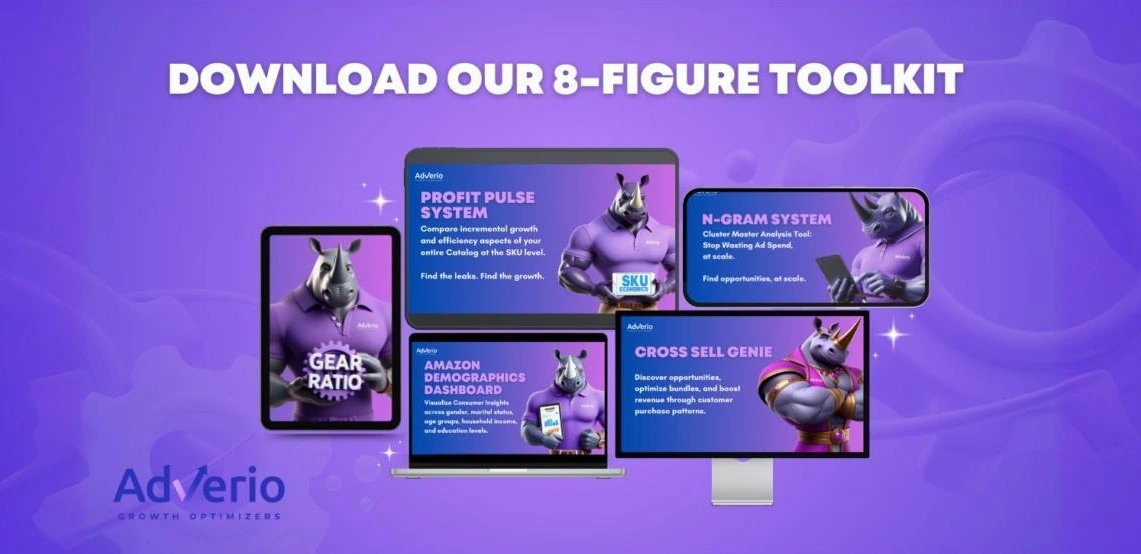Alexa, Play That Amazon Ads Podcast (TAAP)
Which one would you like to hear? The best one.
Join Stephen, Andrew, and Mike as they dive into the intricacies of product targeting and product placements.
Learn the truth about how keywords get triggered by product targeting campaigns and if it would compete with the actual keyword campaigns. Gain insights on how to leverage it to maximize your Amazon advertising performance.
Discover the best practices for branded and non-branded product targeting and how to use negation to refine your search terms.
- 00:08 – Discussion on recent search terms in product targeting campaigns
- 02:18 – Segment product targeting campaigns for different types of targets
- 06:10 – Negating keywords at campaign level for product targeting on Amazon PPC
- 08:06 – Isolating product targets and keywords to specific placements may not be worth the time and effort.
- 12:07 – Using product targeting for Amazon PPC campaigns
- 13:46 – Different campaign setups trigger differently based on demographics and consumer signals.
- 17:22 – Negating underperforming product targets can improve campaign performance
- 19:20 – Discussing product targeting in Amazon PPC campaigns.
- 22:51 – Using autos for product targeting helps to capture seasonality and pick up on changing semantics.
- 24:33 – Product targeting relies on keyword indexing for search visibility.
- 28:03 – Exploring potential scale within product targeting placements
- 29:49 – Segmenting campaigns helps maintain control and maximize reach
- 33:09 – Negating competitor ASINs may not eliminate all indexed queries.
- 34:54 – Importance of data segmentation and cleanliness in Amazon PPC campaigns
- 38:16 – Utilize product targeting and page placements strategically for Amazon PPC.
- 39:54 – Understanding product targeting and page placements for Amazon PPC
- 43:39 – Testing product targeting and page placements impact on Amazon PPC
- 45:27 – Avoid pausing or negating items with no sales to maintain traffic
- 48:52 – Discussion on using other platforms and product targeting capabilities for large campaign sets on Amazon PPC.
[00:00:00] Stephen Noch: Welcome back everyone to that Amazon ads podcast, where today we are doing something extremely unique, not necessarily a PPC debate, not necessarily, uh, your standard typical guest episode. I would say we’re describing this more as a change my mind episode and the way in which this originated was. In our discord community for the, uh, that Amazon has pod, that Amazon has podcast discord.
Uh, there was some discussion going on around the most recent search terms appearing in product targeting campaigns. And like, meaning like keywords are appearing in the search term results. And there were some questions about this, a lot of confusion, speculation. I threw out my thoughts, I posted it on LinkedIn, Mike Danford at Vario responded with his thoughts and we were going back and forth a little bit and we said, you know what, why don’t we just jump on a conversation, put some mics in front of our faces and let everyone listen in because there’s probably a lot to learn from this.
So Mike, how you doing? Why don’t you let everyone know who you are because they might not know.
[00:01:17] Mike Danford: Uh, great, uh, looking forward to this. Um, just came back from vacation. So I was thinking about trying to think about too much, but, um, yeah, so I’m going to say Vario, uh, we primarily work on Amazon, Walmart, Target, and then we go after, um, larger catalogs.
I think thousands of products, hundreds of products, tens of thousands of products. Across the platform, the various platforms with that, there’s a lot of nuances and different tactics we have to take in the ads. And we’ll, we can dig into that today.
[00:01:42] Andrew Bailiff: Awesome. Yeah, definitely excited to dive into this topic, Mike.
Um, this originally came out, we posted a video. We did a whole episode when this first happened. Whenever you’re targeting product targets, starting to see some search terms show up in there. Um, whenever we first did this episode, it wasn’t, we didn’t have enough data to really. See how impactful it was or, you know, how, how widespread it was.
Um, so it’ll be good to dive into this with you, Mike, but as a starting point for us, like what do people need to know about product targeting when it comes to how things are, how things are shaping up and some changes that are happening. within the Amazon advertising landscape.
[00:02:17] Mike Danford: Sure. Uh, and again, the caveat I’ll go back to is we have large catalogs with hundreds of campaigns, thousands of campaigns.
So we have to be really careful when we start having cross contamination of targeting. Uh, so love with the, the ability to have the placement adjustments. And obviously Steven is a fan of that, the software. Um, and then the other part is, you know. A common issue is how people want to separate branded or unbranded, et cetera.
In their targeting segmentation, they go into the PATs as well. And it’s really hard to not have your branded terms. You can’t negate a search term typically in your PAT campaign. Uh, so the way around that is to be really aggressive when I hide percentage, uh, product placement and only put ASINs in there and not really use a PAT for keywords.
Obviously you want to be able to do that. It does help you harvest and follow around your competitors or your brand, et cetera. Um, but you want to keep that data as clean as possible. We have to, because we have such large campaign sets. Um, we, we have seen some impact of negating a keyword at the ad group and campaign level, um, as opposed to just the ad group or just the campaign level.
Um, otherwise it’s, if you’re not using just a product placement, you’re going to have some contamination with search terms in those campaigns.
[00:03:27] Stephen Noch: Andrew, do you have any thoughts?
[00:03:31] Andrew Bailiff: I think, I think we got, let’s, let’s, uh, let’s back up a little bit. So let’s unpack what you’re telling us here. You’re, so you’re telling us basically just from our conversations we’ve already had and, and.
In this episode, you’re telling us that, um, whenever we’re targeting product, targeting camp targets, product targets, we have keywords showing up. And you’re telling us that we should segment those and that we should make our product targeting campaigns specifically go after ACE in targets to where they’re showing up on product detail pages.
So we should have a campaign that’s segmented for that. And we should have a segmented campaign going after product targets. That’s specific to going after top of search, rest of search landing on search terms. Correct. Am I understanding that correctly? Correct. Yes. You want to do both? Yes. Okay. Why should we do both?
[00:04:17] Mike Danford: Well, a few things, one is if you, the biggest thing that we were showing, discussing on LinkedIn is when you negate an ASIN, you’re not just negating that product page or just that ASIN, you’re negating every keyword that ASIN target triggers in that campaign. So if you want to just block the ASIN because you’ve seen it’s got 50, 60, 100 clicks, whatever your threshold is with no sales.
You can’t dis negate the ace and you’re gonna negate all the search terms that may be favorable for it on the cert, where if you had a campaign split and negate the ace and calls, it’s for performing. You still can get the ert best of search, top of search placements in the error campaign. That’s one reason.
Uh, the other reason, lots of other reason. That’s the biggest reason. I think that’s what started to kind of conversation here.
[00:04:57] Stephen Noch: Yeah. So by the way, for the, the listening audience, you’re not gonna see this image that we throw up here, but I’m gonna throw up a screenshot of the original post, and I just realized that this will probably be really helpful.
To ask people or revisit the question that that this individual, uh, Oaks, is that like professor Oaks? I’m trying to zoom in on this picture. No, it’s not. Okay. I saw a little cartoon. I thought it was professor Oaks. Uh, so Oaks said, Hi team, quick question. Since product targeting campaigns trigger keywords to And you can check out that episode, by the way, it’s titled product targeting isn’t what you think it is.
So look for that episode to learn more about what that is. But I think Mike had just said it. You’re not just going after like the ASIN, but basically an index of keywords that that product is indexed for is what you’re really targeting. So he says, it’s product targeting triggers keywords too. Do you think they will compete with actual keyword campaigns?
And the answer is yes, as Mike is saying. Um, and that’s not objective. Yes, they will compete. But the question is, what does compete mean? And then he goes on to say, And will this mess up performance over time? And that’s where Andrew and I, I think, are saying, leaning towards no, and Mike is leaning towards yes.
And then he says, Also, since we can negate keywords in product targeting campaigns at the campaign level. So here’s what he’s saying here. If you have a product targeting, let’s say you have a product targeting ad group, and let’s say you’re trying to defend your own brand. This is a very good use case.
Like you’re trying to defend your own ASINs, you’re targeting your own products, but you end up seeing in the search results that you’re showing up for a bunch of Uh, non brand terms. And this can also happen if you’re going after conquesting, you’re trying to go after other competitor keywords, but on the search term side, you’re actually showing up on branded terms.
So you’re trying to conquest other competitors, but you’re getting sales and brand, and then on your brand defense, you’re getting sales on non brand. So it’s kind of messing some stuff up in terms of the organization, the strategy, the structure. And so you cannot negate those keywords at the ad group level.
In order to clean that up, but you can add it at the campaign level. Uh, but what’s really interesting, and this is sorry, guys, if you’re getting lost in the weeds, it’s very confusing though you for manual campaigns, you can negate keywords at the campaign level, regardless of what ad groups are in there, but you can’t do any negative product targets.
That is a no, no, you could only do negative keywords for manual campaigns. If it’s an auto campaign, you could do both negative keywords and negative product targets. If it’s a manual campaign, only negative keywords. And then when it gets down to the ad group level, you can do either. Negative keywords if it’s keyword targeting, negative products if it’s product targeting.
I know it’s really confusing. It’s been wild for us. The reason why I know all this so freshly in my mind is because we’ve been rigorously testing the keyword harvesting system on, uh, in AdLabs. And this has been the biggest thing when we’re trying to like negate from like the harvested source ad group or whatever.
It’s, it’s been an absolute nightmare, but to conclude this, this guy’s question. He’s saying, if you negate keywords at the campaign level, will that, in effect, create the negative keyword feature for those product targeting ad groups that is currently not available? Like, will that work? And, I actually don’t know the answer to that one.
And hopefully that sets the stage. My response to this was I said, I don’t think trying to isolate product targets to only product page placements and trying to isolate keywords to only search placements, like in the search results placements, is worth the time and effort. And there’s a lot of people out there.
And I know Mike, you were saying that there’s a lot of brands that do need that extra element, but My main point in my response to him that I think everyone can agree with here is that 80 to 90 percent of the PPC managers out there aren’t doing like the three basic things, which is just like, get a good campaign structure in place, get the right keywords and get the right bids.
And that’s the thing where, where people, before they do all of that, they’re trying to dive into these extremely technical and nuanced conversations. And I was just trying to say, a lot of these topics are just like, they’re, they’re hot, they’re sexy, they’re the new thing that everyone’s talking about, they want to talk about date parting strategies and, and placement parting strategies, all that kind of stuff.
So with that, hopefully that, that probably, we probably should have said that at the very, very beginning, throwing up that screenshot just to really set the stage. But Mike, my question now to you is, in response to this guy’s question, do you think that that will mess up performance over time? If you’re, and are you actually trying to accomplish the, that product targeting doesn’t have any search terms appearing in the, uh, search term reports?
Is that what you’re trying to do with that? That product page only strategy for product targets?
[00:09:55] Mike Danford: I’ll answer your question with the question. Cause I actually be curious. I’m, I think you both respond to this. In general, what do you find the CPCs, ROAS, ACoS, whatever metric you want to use, product, when you’re going after a PDP or an ASIN versus a search term, do you see any delta?
Do you see any difference, um, in general?
[00:10:19] Andrew Bailiff: Oh, Stephen go first. Go. Why am
[00:10:20] Stephen Noch: I going
[00:10:21] Andrew Bailiff: first? I was gonna let you go. I want to hear what you say. I have some data. I have some data from a client. So I was gonna let Stephen say his non data answer and then I’ll give you my
[00:10:31] Stephen Noch: data answer. I really like operating just off of how I’m feeling that day.
So the question was, uh, the question was, do I see a big difference between? Product targeting, like, versus keyword generally speaking, is that what you’re saying?
[00:10:43] Mike Danford: Yeah, so, like, in your platform, I believe you’re going to go after a target ACoS. Would you set a different target ACoS for an ASIN target versus a keyword target?
No, I don’t. Even if it’s in a brand or whatever.
[00:10:55] Stephen Noch: Nah. Well, only for, yeah. I mean, I, I separate it by whether it’s brand or non brand. I’ll set different target ACOSs, but not for keyword target, product target. I don’t, I don’t distinguish between those.
[00:11:08] Mike Danford: Okay. And then I think, I think in one of your episodes, it was about your audit process, right?
I think one of your comments is, I believe one of the first things you do is try to clean up the account. I mean, we all deal with that. I mean, we’re all trying to clean up the account when we take over, and that’s segmentation. Um, I believe. I would consider that basic, which is what you’re referring to.
You’re not doing so here. It is what I’m trying to say is this is, this is that, that level, that level that you need to have in order to keep the data clean so that it doesn’t have these debates and you don’t really know it segments that data and keeps it all right from the onset, if you’re going to do branded versus unbranded versus competitor, sir, however you want to do it.
But you need to go all the way down to the targeting to do that as well. Just do it from the beginning. And I think you’re saying that there’s some, uh, complications or that heavy lifting to do that. It’s not. We do it for thousands of campaigns for campaigns and that you just take the same structure and you just put the same ads in there, et cetera, and you put ASINs in there instead of keywords.
And you just, the top of search, uh, and rest of search placements are higher in the keywords. And then the product pages in the other, and it’s, it’s, it’s a mirror. It’s just another campaign. It’s not overly complicated in our eyes. So that’s why we do it as well. And we see the performance
[00:12:18] Andrew Bailiff: benefits from that.
[00:12:20] Andrew Bailiff: I have a question for you. Okay. So with Amazon advertising, you can only win a certain number of placements on any given search result. So if you have a keyword targeting campaign that’s going after this list of keywords for this one product here and then you also have that broad match campaign going after kind of the same keywords still showing up on the same keywords and then you have a product targeting campaign that’s also going after all those same keywords, you see where I’m going, you see where I’m going, there’s only one of them that’s ever actually going to win that placement.
Or at max two on any given search. So if it’s gone, you know, if you’re trying to target keywords and when placement with keywords or the product ad, why wouldn’t you just keep it in a keyword campaign?
[00:13:00] Mike Danford: You can’t. So one, you don’t know what that keywords following is, uh, what, what’s going to happen, what is indexing for a competitor product or your products going to index different over time.
So it’s a little bit of a discovery if you will, in there, but you can pull some of those keywords out. Um, it’s also, again, we’re talking about bids and maybe not going as aggressive on those, or you have a different. Only have a higher multiple on the top of search or aggressive search, et cetera. So it’s something you play around with.
I will go, I’ll take another tangent in there, what you’re referring to, because you’re talking about bid inflation as well, is what I take. Um, so we deal with that. We have hundreds and thousands of campaigns that, with products that are very synergistic. They’re going after, you know, T shirts or bedding or pillows or whatever, and they’re all within the same category.
So we, we go in there and we do see the bid inflation. So there is an inflation, to your point, Andrew, if you’re doing that, and you have a lot of campaigns going after the same thing. So you have to work hard for it. And it with Cosmo and Rufus and all of this search and behavior and consumer behavior that they have we’ve come to find out that having that set up actually allows different campaigns to go and they’ll trigger differently.
We believe, our objective, we don’t have, we can’t do it in the back end, um, that your certain campaigns will serve differently depending on the demographics and consumer signals of the person who’s shopping. So if you just have one campaign set up and it’s really going after. It really works well for this target demographic or these types of users.
This other campaign might do better. Um, that’s another thing we’re looking at. I know it’s a little, little gray, a little confusing. I do want to have objective data behind that, but all of that comes into this. And that’s what we have to keep it clean. So we can tell when that happens.
[00:14:30] Andrew Bailiff: Gotcha. So you’re saying that by targeting keywords in a keyword campaign and targeting keywords in a product target campaign, that you’re getting different audiences by doing that.
You’re potentially reaching different people with the keyword campaign than you are reaching with the. That, and then we also believe there’s a Delta in your CPCs, ACOG. And you’re saying you couldn’t Sorry, sorry not to interrupt you and you’re saying that you wouldn’t reach the same people if you just maximized your keyword campaign.
[00:14:55] Mike Danford: I don’t have an answer on that. That’s what we’re trying to figure out now to see if it does change. I think that your placements are different. I think that the cost competitiveness of the different placements are different from a product campaign versus a keyword campaign. I do think that there is a difference in those.
Difference
[00:15:10] Stephen Noch: how? In performance, in
[00:15:12] Mike Danford: CPCs, etc. Yeah, the efficiency of it, or the efficacy of the campaign. I do think that a keyword campaign is going to do better on keyword targets than a pat campaign on keywords.
[00:15:26] Stephen Noch: But, why, why, why is that? Why is that? If, so, so let’s actually give a, an example. So, uh, we’ve got a brand with electrolytes.
And by the way, we were trying to set up, last week we set up some campaigns where we set up a competitor ace in targeting campaign that was plus 900 percent on product pages. And another campaign that was, uh, competitor product targeting, but plus 900 percent increase for top of search and rest of search.
Excited to come into this episode with some data to look at that zero impressions, despite having like five, 6 bids. And I think that’s just because there could be other campaigns that are like bidding. I mean, we have a competitor keyword targeted campaign. So I guess like to get this, you know, that’s, that’s bidding on the other competitor’s brand name.
And, and we, so I guess the other campaigns was just like picked up all the impressions and it is really difficult to sometimes like funnel. The traffic to one campaign so we didn’t capture the data that we wanted to capture. Um, I don’t think that necessarily like Injured performance, but that’s a good example of also a side note people say that Sometimes campaigns like keywords don’t get impressions if you have more than five keywords in a campaign You can have one keyword or one project in a whole campaign and it can still not get very many impressions Just because there are other campaigns that are picking it up, and I don’t think that’s a bad thing That’s my other like hot take not to derail this conversation.
[00:16:53] Andrew Bailiff: Well, that’s my point on the total number of ad placements It’s like What like, if you’re, it’s all going to funnel into one, it should all funnel. Like, I think you’re just segmenting the audience. You’re segmenting the clicks. You’re segmenting your spend. You’re not actually reaching different people.
It’s just some of it’s going to this one. And some of it’s going to this one. If you just maximize this one and budgeted, fully budgeted this one. All of that spend would be coming through your keyword campaigns. And like we’re seeing with this example, we’re not getting any delivery on this other one because we’re already targeting, targeting the placements that it would hit everywhere else.
[00:17:23] Mike Danford: I think the, the, I think I see where you’re going with that. And the piece I’m referring to is when you negate. So as an example, that shared on LinkedIn, I believe it was that one direct response is if you have a single Pat campaign and it’s going after a. product page and rest of search and you negate an ASIN, you’re going to lose all of the search traffic that it’s following around.
We don’t want that. If an ASIN target is not doing well on its PVP, we want to negate or pause or get rid of that target and only stop that. We don’t want to impact the search that is following around as well. That’s the main purpose of the segmentation.
[00:17:56] Stephen Noch: And here’s actually where I got confused, Mike. And we can also throw up a screenshot of your LinkedIn post as well.
Um, but where I got confused. Was you said you, you were running some aggressive, like you, you did a bulk application of negative, uh, negative product targeting to all these campaigns, but you only picked products that had zero sales. So product targets with zero sales, you mass applied, uh, some negation there.
And then you said that the next day that the top of search and rest of search sales plummeted across that campaign, um, or campaigns. Even though those negative targets, what you were negating had zero sales and so you’re saying it came from those keywords. Where I get confused is, if those product targets had top of search sales on them, it would have been attributed to the product target,
[00:18:55] Mike Danford: right?
I don’t think so, that’s what we’re saying. You go in, so we have tons of product targets that’ll have sales or not, and that’s the whole purpose of what I’m saying here. We negated only targets, ASINs in the backend, that said spin greater than X and no sales. And it blocked all of the SERP that those, those ASINs are showing for as well.
Wait,
[00:19:16] Stephen Noch: wait, sorry. So let’s pretend there’s only one, let’s pretend it’s a single product campaign for simplicity. Okay. So if you have a single product campaign, uh, and with a single target, sorry, single product target campaign, you’re saying that that campaign can have rest of search and top of search sales, while the product target is showing zero sales on it?
[00:19:34] Mike Danford: I, I think that there is a small piece here. You have the image, can you see, is that an automatic campaign? I guarantee, I think it’s what you’re referring to. So I’m talking about negating in an automatic campaign as opposed to a manual product targeting campaign.
[00:19:49] Stephen Noch: Oh, gotcha. That is the source of the confusion, probably.
That’s
[00:19:53] Stephen Noch: probably what we’re, that’s probably what we’re getting here. And were you negating those product targets? Okay. So you’re going through the search term results. of the, uh, auto campaign and you negated a bunch of those ASINs that were appearing. Yes. And then you’re saying that there were other keywords.
That’s kind of interesting to me. I’m still thinking, like, if it had had sales at all from that, from that cert, from those ASINs, like on any placement, then that ASIN should have recorded a sale. It’s gonna be
[00:20:26] Mike Danford: I don’t think so. It’s gonna be search term. It’s gonna be your four. It’s not gonna be an individual ASIN that you’re That you’re gonna show No, sorry.
I
[00:20:34] Stephen Noch: mean I mean in the search term reports, right? Andrew? So, if in a search term report If there’s something that says zero sales on it A certain like ASIN that came up in the search term reports And you negate that You shouldn’t be losing any sales from
[00:20:48] Andrew Bailiff: He’s saying he’s losing He’s saying he’s losing keyword sales when ASIN.
[00:20:53] Mike Danford: If you’re going in the actual, like, the manual search term report you pull out, I believe, does it still have the asterisk in there as the targeting?
[00:21:00] Stephen Noch: Um, only for like super legacy campaigns.
[00:21:04] Mike Danford: Okay. I don’t think
[00:21:05] Stephen Noch: for the,
[00:21:05] Mike Danford: yeah. Again, what I’m saying here, and I think we’re agreeing now, and it makes sense with the automatic versus the PAT here, is that when you negate an ASIN that is showing in the search term report of not good performance, You are going to impact it’s cert that is falling around as well.
[00:21:22] Andrew Bailiff: Specifically in the auto. My thought on that is just like, why, why are we leaving so much spend in autos anyway? Like I’m just harvesting out of my autos and like, I’m not trying to keep those running anyway. And. You know, like who cares at this point, you know, that’s just like splitting hairs. I’m kind of just like, I’m just going to harvest out of it and be able to control it much more easily.
And forget about this, like nuanced conversation.
[00:21:45] Mike Danford: All right. Great. Uh, Steven, what’s the largest, um, product catalog that you manage or, or, or see on a daily basis? And we’re talking like number of SKUs that you’re actually advertising. Uh, 2000.
[00:22:01] Andrew Bailiff: Okay. Andrew, I think you have one that’s bigger, right? Yeah, I have one that does between, I don’t know, 30, 000 or something like that.
Excuse. All right.
[00:22:10] Mike Danford: Uh, Andrew, I’ll go to you because you got, you got larger, so it’s a little more comparable where I’m going with this.
[00:22:14] Andrew Bailiff: We don’t, oh, sorry, I should clarify. We don’t, we don’t support all of those. We have like segments of the catalog. We do support them. I don’t. So it’s still in the thousands, you know.
Yeah, we’re still in
[00:22:22] Mike Danford: the thousands. What are your, what are your CPCs for that? Do you have cheap clicks in that account compared to your other accounts? Yes. Where do those sheep cliques typically come from? If you’re not doing the auto and the long term harvesting, where do your sheep cliques come from?
[00:22:37] Andrew Bailiff: Off the top of my head, I mean, I don’t know exactly. I would suspect
[00:22:41] Mike Danford: it’s ASIN or PDP.
[00:22:42] Andrew Bailiff: I can tell you it’s not that. Is it relevant terms? Is it relevant terms? Are they, are they, is, these cheap clicks, are they relevant?
[00:22:51] Stephen Noch: Just open it in AdLabs real quick and just, uh, Yeah, let me look it up. Let’s look at the search term report,
[00:22:55] Mike Danford: sort by lowest, uh, CPC.
While he’s, while he’s loading that, we’re again, uh, now there’s large catalogs, uh, some of them have high AOV and they’re going, they’re shopping, they’re winter shopping, so you’re gonna click a bunch of PVPs and you get a bunch of really cheap. Clicks from it, and it will eventually it will compound, but the conversion is a lot longer, right?
It could be 30 or 40 clicks before you get it. So you get a lot of clicks that are really thin across a lot of products, but you’re also, you’re pulling those products in. You’re getting the, you know, the filling up your DSP and PDPs and all that stuff. So you’re following, you’re, you’re, you’re building the awareness elsewhere as well.
So that’s part of the reason why we keep some of the autos going for those low cheap clicks because it does work. We also have a ton of seasonality. So a lot of our brands will have six, seven tent poles in a year, all around the holidays, etc. The semantics will change so much from one year to the next year for a holiday or a regional pickup or a design that didn’t do well last year does really well this year.
And that’s why we have to have the autos on because it helps us pick up on the semantics. We can’t go through, um, well, we have an RPA for query, you know, search query performance, but you You can’t go through thousands of products, search queries, performance. And if you go with the brand performance, you can’t see it.
You can see at the top couple thousand, uh, search queries. So again, the autos help us catch that as well, over time, four different 10 pulse, that’s why we have to leave them running.
[00:24:21] Stephen Noch: Yeah. So I do see an interesting point here where if. For all intents and purposes, uh, product targeting is essentially, it’s, it’s a form of, uh, targeting a basket of keywords with phrase match, basically.
And, so whatever keywords that product’s indexed for, you can appear it on those search pages. And I do see how if you negate that ASIN, let’s just say, like, that product target was previously, uh, let’s just say you’re selling electrolytes, and you negate a competitor’s ASIN because you’re like, we don’t really want to be focusing on conquesting in this one, we just want to be focusing on non brand, but because that ASIN was indexed for all of these, you know, electrolyte keywords, you’re saying that you would now suddenly Not appear on any of those search, like you would also negate all of those keywords with that product target, which is very interesting.
I didn’t think about it unless
[00:25:17] Andrew Bailiff: that’s the case. Um, so like if I have a, let’s just say I have an auto campaign for one product and I negate all of my brand aces from it, all of those brand aces are going to index for, uh, non brand keywords, but my auto campaign still shows up on those. That’s true.
No, you’re saying that if I negate an ASIN, I, in effect, negate all of the keywords that are indexed for that ASIN or that index or that that ASIN indexes for,
[00:25:48] Mike Danford: right? Can’t say all because we don’t have a campaign with a single ASIN or we’ve negated a target, but I can tell the picture will clearly show that we’ve negated thousands of ASINs and those that, again, non converting and you lost the last search.
I have not, we don’t, we don’t run single camp. I mean, very rarely do we have a single campaign with a single product. It said it doesn’t work in our space, but I mean, that’s an easy test to find out what you’re talking about there. And just to, so I understand what you’re saying is. You got a branded campaign, you drop in a branded defense, you’re on ASIN or whatever in there, and you go in and negative match your ASIN.
Okay, go ahead then.
[00:26:22] Andrew Bailiff: Well, kind of, but I’m just saying I’m going out, it’s a non brand campaign, let’s say it’s a, whatever, and I negate, I negate all of my brand ASINs because I want to make sure that that campaign is not showing up on any branded, So all of my branded ASINs index for keywords, right? Non brand keywords, branded keywords, competitor keywords, whatever.
I negate all those, but my auto campaign still shows up on non brand keywords. So I didn’t negate all of those associated indexed keywords by negating my brand ASINs. So it’s like that, that theory doesn’t really hold up on both ends of the spectrum, like negating competitor ASINs. Now I’m losing all my.
Sales on, um, all of those keywords, but it doesn’t work on my, when I negate my branded keywords or my branded ASINs. See where I’m going? Is there a make sense?
[00:27:07] Mike Danford: Yeah, a little bit. So I’d be curious on, Oh, let’s actually confirm this because I actually was trying to confirm it before we came on the call. So if you negate, I’m just trying to think of how to word this.
I can’t, I can’t articulate it correctly right now. But it’s along the same way of what you’re talking about. If you negate an ASIN, you’re still trying to show up on a cert. And you’re, you’re saying that, that you are still showing up on a SERP, even you’ve done this?
[00:27:33] Andrew Bailiff: Yeah. Yeah, for sure. Like those campaigns are still getting placement on non brand keywords.
Okay. Even though I’ve negated those ASINs
[00:27:41] Mike Danford: that Like, what is the, what is the place? So I think, okay, when you see placement, top of search, rest of search, or product page, do you, if you have a, only the product page placement, let’s say it’s high, right? Let’s just say you got nothing on rest of search or whatever.
You’re not technically triggering on SERP. Would you still get search terms in that campaign? If you’re high product page and your bid, let’s just, and you don’t get, yeah, I don’t actually,
[00:28:06] Andrew Bailiff: you know, I don’t actually know that because that’s something we were trying to test. We were trying to see. If that was the case, I assume that’s probably the case.
And this is what I’ve always thought is like the, the, you know, like the placement or the, yeah, like where it shows in the placement is indicative of where it actually showed up. So like in your product targeting, when you’re seeing spend on your product page placement, that’s actually going to that placement on product detail pages.
Right. Right. Like, and so what I see in this whole conversation and what I was trying to get out of this and the whole point of this is like. Is there increased scale within product targeting, um, placements and that we’re not fully tapped into because we are, we’re, we’re mixing keywords, which have, you know, higher CPCs and lower conversion rates or whatever compared to product detail pages.
But I don’t know if that’s always the case or if that is actually the case, because typically product detail page placements don’t convert that well. But anyway. That’s kind of the main point I was trying to get to is like, is there a scale by doing this? Like where you can bid much more aggressively here on product, product detail page.
Pages. And I don’t know, that’s what I was trying to
[00:29:15] Mike Danford: tentpoles, the reason we do autos and the pads and everything else, where we’re trying to chase around the competitors, uh, whether it be an auto or, again, a pad, is that we have so many designs and brands that will trigger so many other products and that we don’t want to lose those placements because a training product may take off or a product that we can win on may pop up that we can’t see because we’re managing tens of thousands of products.
The brand doesn’t even know. That their competitor released a style that’s competing with them or a pillow or whatever it is This helps us constantly do that And that’s why we have the segment because it keeps helps us keep that control in place with keeping the reach out there
[00:29:54] Stephen Noch: All right. I don’t know if this is going to be very helpful, but I was digging around in our Insulted campaign because that’s the, that’s the brand we’ve been screen sharing the journey with.
So if you guys have been following along with that, I think we’re three episodes deep into it. So this one, we can share this brand, uh, we have an agreement that we can share their data. So we have an auto campaign that is focused on discovering some non brand keywords because we wanted to discover more non brand keywords.
We added to this auto campaign at the campaign level. We negated all of our branded terms, as well as our core competitors brands. So we negated Insulted, plus variations of that. We also negated Element, plus variations of that. And then we also negated all of our ASINs from the product targeting, as well as, uh, all of our competitors, like, kind of the top, like, 10 or 15 or 20 ASINs.
Now, when we click into this campaign, and I’m looking at just August 1 through 8, and I’m just, it hasn’t spent very much, only 10 bucks over the past, like, 8 days. Right now 100 percent of the, the search terms coming through the reports are actual queries. Electrolytes is in there. So I think that was one thing that Andrew and I were thinking was that if you negate all these product targets, you would think that you’re also kind of getting negated from like, Oh, it’s really tricky because you don’t know like, when you negate an ASIN, what are you negating?
Are you also negating all these keywords? Or like what is actually going on there? It’s interesting that we’re still appearing for electrolytes because that’s like the one definite keyword that all of these products have been indexed on. So, that’s interesting. But then, if I go into the placements tab for the same date range, um, oh yeah.
I am seeing that so far. All of that spend was on rest of search and top of search. So there were no ASINs that came through in the search term reports and also no product page spend. However, we do have like 50 percent increase for rest of search and over a hundred percent increase for top of search based on some of just like averages and performance stuff.
So I wasn’t really having a, uh, any like, therefore at the end of this, so that it was more just. That kind
[00:32:04] Andrew Bailiff: of confirms what we were talking about, right? That, that just confirms like, you know, the, what’s showing in the placement report is indicative of what’s happening in the search terms. And that all the delivery on that campaign was on search terms.
We’re seeing that all the spend on those placements inside that campaign was top of search, rest of search. Nothing on product pages. Could be. We’ll
[00:32:24] Stephen Noch: have to keep investigating more. Yeah. More auto campaigns. Mike, your thoughts?
[00:32:31] Mike Danford: I was just trying to, I was really digesting what Andrew was talking about because I’m trying to do, we have some of what he’s talking about with his campaigns and I’m trying to think of, I want to go back to it.
Negate the, you need to negate the ASINs but you still will show up for search. Is what you’re saying, right, Andrew? And the products that you’re negating with your brand is triggering for those, right? Yeah, for sure. But you were also, what is your other target? It’s an auto campaign, right? So it’s going to be triggering other ASINs and other products and other search terms.
So you’re only negating those, right?
[00:32:59] Andrew Bailiff: I feel like I’m getting kind of lost in the weeds of that particular conversation. Not going to lie with you, that’s, it’s a little bit far removed, but in regards to this specific example that Steven was talking about, I’m actually looking at it too now, so I can kind of see it, so it’s a little bit fresher.
I think what we’re trying to get to is, or what I was trying to get to with that was just that whenever you negate, competitor ASINs, um, you will, or you’re, you were saying that you would negate all those indexed queries. And I was saying, I negated all my brand, my own ASINs that are definitely indexed for certain queries, but then my auto campaign is still showing up for those queries.
[00:33:38] Mike Danford: Okay. I think so. I mean, one, we have already, we’re showing it’s at a larger scale and I’m trying to figure out the simplest way to, well, we think, right. We still don’t know it. It was being ran while I’m on vacation, just came back from vacation. I imagine that there’s another ASIN or a keyword that’s in there that’s triggering that outside of just your branded ASINs.
I don’t know if you’re full, but to your point, I don’t know if you’re fully negating every keyword that your product triggers for, but if there’s another product in that campaign or another, whatever trigger that you didn’t negate, it’s a competitor ASIN that that’s follow around. You’re gonna get that search term pop up.
And I think that’s what you’re saying. Like you’re negate, you negate, I dunno what I’m saying. Yeah, I think you’re saying you negate your brand Aon and. Let’s just go that say it’s element or whatever right and it’s indexed Well, let’s use electrolytes say it’s in your ASIN is indexing for electrolyte and you’re saying if you negate your ASIN You shouldn’t show up for electrolyte anymore because you’re on based on what you were telling us.
Yes, right I believe that the other products in that campaign or the other ASIN is not your product. What if it’s just one? What if it’s just one? And we’re talking about an auto campaign, right? Oh, you were talking about the targets not the ad not the one product. Okay Uh, dude, I think we’re getting lost in the weeds here.
That’s what I’m saying, man.
[00:35:03] Stephen Noch: Andrew, Andrew sent me a, before we hit record, Andrew sent me a message saying, this is about to get so confusing. Yeah.
[00:35:11] Mike Danford: Um, I think the takeaway here that I’m One, while we’re having the conversation is We like, we’re trying to clean up as much data as possible from Amazon because it is so commingled and it changes over time.
Campaigns get, uh, deprecated, the targeting comes out, those that sling out stuff don’t tell you, Hey, we’re going to start showing up for cert in your product campaigns and vice versa and you don’t really know. When we do the segmentation out of the gate, it helps us know or see that’s happening. It also helps us keep that data clean in the back end as much as possible.
Again, managing larger campaigns, larger ad groups, et cetera. We don’t have the luxury of being able to do that where you have a lot of single keywords, single product campaigns. So we need as much segmentation and as clean as possible for us. So when we see something we can react to it. If we go in and negate, like I showed you in that picture, Hey, negated my schedule performing ASINs.
Oh, shoot. That had a ripple effect that doesn’t work because that campaign didn’t have that segmentation in it with the top of search, product placements, etc. If we had, if that was segmented correctly, which is what we did after the test. Now when we negate an ASIN, we’re only negating that ASIN on that product detail page.
We’re not negating it CERT. That’s what I’m referring to. We have to. Yeah.
[00:36:23] Stephen Noch: What I, so you’re saying this is only for, this is for harvested product targets you’re doing this, not for your auto campaigns? Like you don’t have an auto campaign that’s, you know, only, uh, search targeting and then an auto campaign that’s only product page targeting, do you?
[00:36:39] Mike Danford: So in this case, we’re talking about an automatic campaign like that. So we have, we’re trying to test that to see if it’s the same benefit as a product targeting campaign, where we talked about earlier about going into product pages versus rest of search with ASIN targets and automatic campaign. We do have.
Call to auto cert where we’re testing, Hey, let’s just have really high or higher relative, um, rest of certs, top of certs and product page and just go after certs to clean it up as well. We’re trying to see if that’s the fix as well. That’s a cleaner fix. It’s a simpler fix to Andrew’s point where when you negate a bunch of ASIN, it’s got a bigger impact on it than you want.
You don’t want to negate an ASIN. You want only, if you don’t want a keyword to show up, you don’t want, you just negate the keyword, not the ASIN.
[00:37:23] Stephen Noch: On that screenshot from your example, when you negated over 2, 000 ASINs that you were saying had zero sales. Give, give me a little more context around this, this campaign. Like, would this, this is an auto campaign? How many, like, ad groups are in this campaign? How many product ads are in that campaign?
[00:37:41] Mike Danford: Uh, generally speaking, probably three or four ad groups to based on substitute content, et cetera.
I would assume that’s kind of the general issue, Will. It’s not a campaign we had originally set up, so I can’t give you 100%. Um, but that’s gonna be kind of it. And then you’re gonna have, um, the way we do it, we try not to hit more than a hundred, um, ads or products in a single ad group. Um mm-hmm . You go over that, you lose some settings, especially in sponsored display where you can’t do custom images, et cetera.
So we lose some features and also just gets cleaner, um, or have more leverage to, than, you know, a hundred agents that we’re impacting. Right. Or a hundred keywords or a hundred products or. You know, you only got one lever of budget you can pull and one lever of rest of search or product search, et cetera, product pages, et cetera.
Um, that campaign would probably have had several hundred products in it, in each ad group.
[00:38:27] Stephen Noch: Yeah, and you said this, this, and this brand has like, how many SKUs did you say? Tens of thousands? Uh,
[00:38:35] Mike Danford: that’s,
[00:38:35] Stephen Noch: that one’s
[00:38:35] Mike Danford: over 10, 000, yes. I think it’s around 12. And another, another thing that that, the reason why we have to do that is, They lose the buy box.
So maybe it’s a, uh, this not specific to that one, but a certain size or a certain color of a product goes out of stock. So you want to have the, the other sizes and other variants in there as well. So they pick up. So the campaign doesn’t tinker over time. I constantly look when you have tens of thousands of products, man, if I speak this on the other account, things go out of stock.
Yep. And it happened. Yeah. Um, and it’s, you don’t want your campaigns to tank because one product is out of stock. You want it to be able to continue to go and control with that parent and keep that parent afloat while the, if the hero async is out,
[00:39:17] Andrew Bailiff: it’ll come back. I feel like a lot of that’s taken care of, like with your, how you’re setting things up.
And I mean, you definitely do want to have a lot of, you know, supporting your full catalog in there. So when stuff goes out of stock, especially in these larger apparel type things, rotating it in and stuff like that. But, um, I feel like as long as you have those set up in some fashion, whether they’re in the same ad group or in another campaign.
It’s just going to like shift where that spend is going. And I see that a lot with the, the campaigns, the keyword campaigns and product targeting campaigns. We’ll see, you know, certain times, like our product targeting campaigns will get more of the attribution and more of the spend. And then it’ll kind of shift back over to keyword and to kind of see this rotating between the two, uh, campaigns for any individual product.
So it’s definitely interesting nonetheless to, to observe and see. Um, I think I’m definitely gonna have to go back and do a little bit of, of investigation and testing and set up and see exactly. What, what moving certain levers does and what sort of impacts each one has. Cause it’s not something I’ve dealt into fully enough, probably based on this conversation.
So it’s definitely something to, to look at. I’m, I’m curious to see how much added value is in, in that level of, uh. Uh, complexity or, um, you know, the minutiae that you have to get into.
[00:40:32] Stephen Noch: I will say, uh, going back to earlier when we were just, you know, we were looking at the auto campaign and I said there were five search term clicks and five, uh, clicks on like the, in, on the campaign placement settings, uh, showing in search.
I just found another campaign that, that had a whole bunch of product page clicks, but the campaign placements were still saying that, or sorry, the campaign placement settings had a bunch of product page clicks, but the search term reports was only showing search queries, no ASINs. So it’s certainly not one for one correlation between like, in your search reports, if you’re getting an ASIN or if you’re getting a keyword, that means you’re getting that, that specific placement.
Um, so that was just like, clarifier for, for the listening audience, but then going back, Mike, to your example. With this, this negative, you, you archived 2, 000 ASINs that had no sales reported within like, what was it, 90 days or something like that?
[00:41:27] Mike Danford: Yeah, usually it’s 30, 60, 90,
[00:41:28] Stephen Noch: depending on what kind of recency we want.
And then, on average, like, what’s the conversion rate, like, super average for this brand? That brand?
[00:41:37] Mike Danford: Yeah. Uh, it’s low single digits for that one.
[00:41:41] Stephen Noch: Yeah, that’s what I would expect. So, two things here. Number one, I really find it hard to believe that these ASINs were previously driving sales and not getting the sales attribution in the search reports.
That’s something that I’ll have to continue going back with and testing, but I think what you’re saying is they picked up sales from keywords and they didn’t get the sale. The keywords won the sale, not these ASINs, but when you negated these ASINs, it then In effect negated that keyword and that’s on that that I’ll have to go back and check what I think happened Here’s why I think the sales dropped and this will kind of be my concluding thought here I don’t negate I think if you negate stuff with one click and no sales You like if you do that a lot you’re gonna lose sales and the reason for that is you have a bunch of other stuff with one click and And one sale, so you have a whole bunch, especially in these bulk, massive, like, uh, campaigns or these massive catalogs where you basically just have a, you know, tens of thousands of queries, always super, super low data.
You’re going to have a bunch of stuff that gets a sale every once in a blue moon and everything else that has like one click and no sales, even though it looks like you’re not going to lose any sales. The other, all the other ones that had one click and one sale aren’t expected to. To get that sale as frequently and repeatedly, you need all those other items with just one click to get that second click to get that sale, if that makes sense.
So you, you basically just lost a ton of traffic is what I’m saying. So there’s no individual search term or keyword in there that’s being the main driver of the traffic. It’s just a bunch of low data stuff that’s all averaging out to get a certain amount of sales. But when you negate like 80 percent of the traffic, even though it didn’t have any sales.
That’s all stuff that was kind of next in line to get that conversion on the next click that you lost. Not sure if that makes sense. Probably didn’t do a good job explaining that.
[00:43:47] Mike Danford: Do you have the image? Do you, does it, does it show the date range on there? I don’t want to say it was like
[00:43:51] Stephen Noch: pre and post Prime Day.
Uh, it does, yeah. So, so it’s from It looks like the 2000 Aces were negated on June 26th. And then they came back on July 15th and 16th, which is yeah, right. So that’s a rolling day actually.
[00:44:07] Mike Danford: 90 days. Um, To again, this was a test again This is not a practice that we use on a regular basis the test to see what happened.
Hey, this is blowing up How do we get rid of spin that’s not, uh, fruitful, right? Let’s see what happens and this is what happens. Um, so when we’re rolling back 90 days, so to your point of frequency versus statistical significance Um a bit nuked here because we’re looking at 90 days rolling again if we’re getting rid of targets that have not generated cells and we have Thousands of other targets and keywords that are generating sales.
And I believe it’s in the five or six figures over that time for that campaign. I’m not a hundred percent sure. I don’t have it sitting right in front of me. We shouldn’t have it. I can,
[00:44:50] Stephen Noch: uh, yeah. So the audience, so our, our YouTube audience will be seeing this. Although I just noticed something. So you negated the ASINs on June 26th, but then you unarchived them.
On July 15th, and then it looks like the sales spike through July 16th and 17th, which is Prime Day. And then it looks like they go back down to zero on, like, the 18th and 19th. Yeah, there’s commentary either
[00:45:18] Mike Danford: on the text or on the post, on the image or on the post itself. We, because Prime Day, one of the campaigns that they were saying they wanted to be disruptive for this campaign, we don’t want to test during Prime Day, so we archived them so they would regain that traction.
And then two or three days, whatever the date and time was after Prime Day, we Negated again, went back to the new campaign structure. We don’t want to be launching new campaigns and prompting. Mm hmm. So that’s the big spike. And that should be, it’s in text on the image, it might be hard to read, but
[00:45:47] Stephen Noch: Yeah, I see the, the archived, uh, but Yeah, I guess my, my takeaway, for what it’s worth, I would say that is why I don’t pause or negate items with one click and no sales.
Because those are things that are very likely, uh, you know, you need that cumulative traffic where if you have a hundred, if you average a 1 percent conversion rate, let’s just say you need a hundred, you can have a hundred items that all have one click and no sale. And one of those is going to get the sale and you need that cumulatively.
If you then negate the 99 that didn’t get a sale, you’re very likely not going to get any more sales because. Yeah, just if you’re assuming you had a hundred terms at all, we’re getting one click, only one got the sale, but you need a hundred clicks worth of traffic to get one sale and you negate the 99 percent of stuff that’s Of your traffic just because it didn’t have a sale because you lose that traffic.
You’re gonna lose the sales I think that’s what happened with those negative that bulk application of negative ASINs I think it just costed a lot of traffic. I don’t think those were Necessarily like that they were previously getting sales, but Amazon wasn’t giving the attribution properly to those targets.
That’s my thought That’s where I’ll, I’ll,
[00:46:57] Mike Danford: uh, conclude. And the response that is, there are still other hundreds, if not thousands, of keywords and targets that are in that campaign still triggering the traffic and sales order. In theory, it should be, because you didn’t get rid of them or you negate them.
And that’s what the point is, is like, hey, you actually did negate those by negating the ASIN. Right. That’s Andrew’s comment earlier. It’s like, ah, if I negate all my branded ASINs, I lose all my indexing. That’s, that’s where we’re at. I mean, it’s trying to figure out, is that really what’s going on? Andrew, where do we go from here, man?
[00:47:25] Andrew Bailiff: Well, I think we got to go, we got to go back into the lab, my friend, and we got to, we got to just do a little more investigation and figure out what’s what here. And, uh, it’s been good. I mean, you came on here to change your mind. I don’t think you changed my mind yet. You’ve, you’ve changed the fact that I’m going to do a little more investigation this week and, uh, maybe set up some, some different campaigns to test a little bit more, but.
Hey, that’s progress and that’s good. And it’s been a insightful discussion. I mean, if nothing else, people got to hear some, uh, unfiltered conversation between two PPC or three PPC people. So
[00:48:02] Mike Danford: yeah, I’m looking forward to what you find out. That’s why, that’s why I’m bringing it. That’s why I’m is I won’t, I won’t like, are you seeing this?
Is this the same thing? Is it campaign type? Is it age of campaign? Is it the number of products? Is it number of keywords? It’s a level of spin.
[00:48:15] Stephen Noch: Yeah. So, like Andrew said, back to the lab again, as Eminem also has said, and back to the AdLabs again. Mike, you’re an AdLabs user. I know Wayne from your team was reaching out about keyword harvesting, when that was going to be ready.
Uh, like we said earlier in this episode, uh, we’re testing right now, but hopefully by next week. Would you mind giving everyone just a quick, like. You know, five second, you know, thumbs up, thumbs down on AdLabs. Your, your, your thought as an agency using it. Uh,
[00:48:46] Mike Danford: well, one is use other platforms and they break, uh, the best feature for us.
As you can imagine, large campaign sets, large products, hundreds of thousands of search terms is your paid non pagination. Thank you so much for that. Uh, yeah, I have, we have crashed it. It does crash and we try to load search terms. Uh, it seems like about a hundred thousand it breaks. Um, and, uh, but aside from that, uh, response to this is great.
I don’t use it as much on a regular basis. I get in for these types of things. Uh, but the team has been very, uh, positive feedback for it. And again, it manages our larger catalog. So that’s much appreciated.
[00:49:23] Stephen Noch: Awesome. Thank you, Mike. And then if people want to get in touch with you, what’s the best way to do that?
[00:49:28] Mike Danford: Yeah. Uh, so adverio. io forward slash, uh, ad labs. We’ll have a page for you there. We have an eight figure tool kits, a bunch of tools that I build that we have to use for our larger brands. And they help other sellers as well. So for your listeners. Awesome. Awesome.
[00:49:44] Andrew Bailiff: Well, thanks again, Mike, for coming on and for everybody tuning in, come back next week for another episode of that Amazon ads podcast, don’t forget to like and subscribe and we will see you next week.


